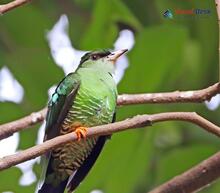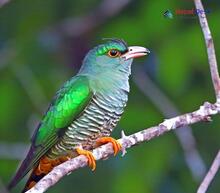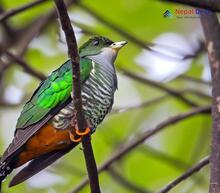Nestled amidst the majestic Himalayas, Nepal boasts an incredible wealth of avian species that attract birdwatchers from around the world. One of these fascinating treasures is the Chrysococcyx genus, a group of cuckoos known for their striking colors and melodious calls. Here we delve into the classification, common features, evolutionary relationships, and nomenclature of Chrysococcyx birds found in Nepal.
Classification - Chrysococcyx Cuckoos within the Avian Kingdom
Belonging to the Cuculidae family, the Chrysococcyx genus contains about 15 species of cuckoos, several of which can be found dwelling in the forests of Nepal. Most notable are the Asian Emerald Cuckoo (Chrysococcyx xanthorhynchus) and Violet Cuckoo (Chrysococcyx xanthorhynchus). These spectacular birds are classified within the Aves class and hold a distinctive place within the avian kingdom due to their unique features.
Common Features - Identifying a Chrysococcyx Cuckoo
The name "Chrysococcyx" is derived from the Greek words 'chryso', meaning gold, and 'kokkux', meaning cuckoo. This hints at their most striking feature - their gleaming bronze-green or violet iridescent plumage. In addition to their vibrant colors, Chrysococcyx cuckoos typically have a slender body with long tails that aid in agile flight through dense foliage.
As with other cuckoos in the Cuculidae family, many Chrysococcxy species are brood parasites. They lay their eggs in the nests of unsuspecting host birds, relying on them to rear their young.
Evolutionary Relationships - The Chrysococcyx Lineage
The Chrysococcyx genus is considered to be an early diverging lineage within the Old World cuckoo group. This implies that these birds have maintained some ancestral traits and show significant differences from other cuckoo genera. Recent molecular studies suggest that the evolution of Chrysococcyx began about 15 million years ago, with multiple species radiating from a common ancestor due to geographical separation.
Nomenclature - The History and Significance of Names within Chrysococcyx
The naming conventions within the Chrysococcyx genus typically reflect their physical characteristics or geographic distribution. For instance, the Asian Emerald Cuckoo's scientific name, Chrysococcyx xanthorhynchus, alludes to its gold-colored beak ('xantho' meaning yellow and 'rhynchus' meaning beak). Meanwhile, the Violet Cuckoo's name refers to its dazzling violet-hued wings.
In conclusion, the Chrysococcyx cuckoos of Nepal are a captivating part of the region's rich birdlife. Their intricate classification, vivid plumage, fascinating evolutionary history, and evocative nomenclature contribute to their allure as they continue captivating birdwatchers worldwide. So next time you embark on a birdwatching expedition in Nepal, keep an eager eye out for these gleaming treasures hidden amidst the foliage!




